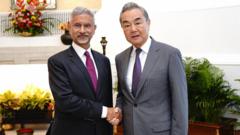With China's exports being limited, nations like Vietnam and Indonesia find themselves squeezed between the US and China, necessitating strategic economic decisions going forward.
**Trump's Tariffs Create Tough Dilemma for Southeast Asian Nations**

**Trump's Tariffs Create Tough Dilemma for Southeast Asian Nations**
Concerns grow among Southeast Asian countries as they navigate the complexities of Trump's trade policies.
South East Asia finds itself at a critical juncture as trade relations undergo significant upheavals thanks to President Donald Trump's tariffs on Chinese goods. The vast economic implications of these tariffs ripple through the region, affecting businesses and economy alike.
Vietnam's entrepreneur Hao Le capitalized on the opportunity created by Trump's initial tariffs, with his company SHDC Electronics supplying $2 million worth of tech accessories monthly to the US. However, looming 46% tariffs on Vietnamese products threaten his business's viability. He points out that with heightened competition from cheaper Chinese imports in Vietnam, local firms struggle to compete.
The 2016 introduction of Trump's tariffs led to a surge of inexpensive Chinese imports flooding Southeast Asia, negatively impacting indigenous manufacturers but allowing some to establish new ties in global supply chains. Now, the prospect of renewed tariffs could undermine this progress. Nations like Vietnam and Indonesia are battling for a greater foothold in emerging sectors such as semiconductors and electric vehicles, firmly caught between the US and China—the world's largest economies.
Chinese President Xi Jinping recently visited Southeast Asia to reinforce economic relations against the backdrop of Trump's tariffs. Countries such as Malaysia emphasize their strategic value and aim to avoid being forced to choose sides, as noted by their Trade Minister, Tengku Zafrul Aziz. He stated that protecting their economic interests supersedes aligning with either superpower.
In the wake of Trump's tariff announcements, Southeast Asian governments have proactively sought to strengthen trade relations with the US, negotiating terms that may protect their export interests. For example, Thailand is working to elevate US imports and secure investments. The broader regional economic agenda focuses on rising stability amid tariff uncertainties, recalling the urgency for nations to diversify trade partnerships.
Chinese exports, which are crucial for many Southeast Asian economies, are seen as both a competitive threat and an opportunity. Yet, local businesses are now confronted with intensified competition as Chinese products that can no longer be exported to the US are finding new markets in neighboring countries. As Indonesian business owner Isma Savitri noted, the race to offer competitive pricing against an influx of Chinese goods is daunting.
Despite apprehensions, many nations may find unexpected benefits from the shifting landscape. Those like Vietnam are seeing increased inquiries from US customers exploring alternatives to Chinese suppliers—a shift that could reshape regional manufacturing dynamics. As Malaysia’s rubber manufacturing sector positions itself to capture market share from China's dominating presence, there’s cautious optimism within the region. While existing baseline tariffs remain, many businesses predict that the potential offset may favor those who can navigate the complexities of international trade effectively.
The prevailing sentiment among experts is that Southeast Asia stands to gain as a consequence of the US's volatile trade strategies. Nonetheless, the challenge remains for these nations to balance their contracts with reliance on a diverse array of trade partners, ensuring economic resilience and avoiding overdependence.
In conclusion, the current landscape of tariffs reveals both challenges and opportunities for Southeast Asia, prompting a necessity for strategic choices as nations are drawn into the complexities of global trade dynamics.
Vietnam's entrepreneur Hao Le capitalized on the opportunity created by Trump's initial tariffs, with his company SHDC Electronics supplying $2 million worth of tech accessories monthly to the US. However, looming 46% tariffs on Vietnamese products threaten his business's viability. He points out that with heightened competition from cheaper Chinese imports in Vietnam, local firms struggle to compete.
The 2016 introduction of Trump's tariffs led to a surge of inexpensive Chinese imports flooding Southeast Asia, negatively impacting indigenous manufacturers but allowing some to establish new ties in global supply chains. Now, the prospect of renewed tariffs could undermine this progress. Nations like Vietnam and Indonesia are battling for a greater foothold in emerging sectors such as semiconductors and electric vehicles, firmly caught between the US and China—the world's largest economies.
Chinese President Xi Jinping recently visited Southeast Asia to reinforce economic relations against the backdrop of Trump's tariffs. Countries such as Malaysia emphasize their strategic value and aim to avoid being forced to choose sides, as noted by their Trade Minister, Tengku Zafrul Aziz. He stated that protecting their economic interests supersedes aligning with either superpower.
In the wake of Trump's tariff announcements, Southeast Asian governments have proactively sought to strengthen trade relations with the US, negotiating terms that may protect their export interests. For example, Thailand is working to elevate US imports and secure investments. The broader regional economic agenda focuses on rising stability amid tariff uncertainties, recalling the urgency for nations to diversify trade partnerships.
Chinese exports, which are crucial for many Southeast Asian economies, are seen as both a competitive threat and an opportunity. Yet, local businesses are now confronted with intensified competition as Chinese products that can no longer be exported to the US are finding new markets in neighboring countries. As Indonesian business owner Isma Savitri noted, the race to offer competitive pricing against an influx of Chinese goods is daunting.
Despite apprehensions, many nations may find unexpected benefits from the shifting landscape. Those like Vietnam are seeing increased inquiries from US customers exploring alternatives to Chinese suppliers—a shift that could reshape regional manufacturing dynamics. As Malaysia’s rubber manufacturing sector positions itself to capture market share from China's dominating presence, there’s cautious optimism within the region. While existing baseline tariffs remain, many businesses predict that the potential offset may favor those who can navigate the complexities of international trade effectively.
The prevailing sentiment among experts is that Southeast Asia stands to gain as a consequence of the US's volatile trade strategies. Nonetheless, the challenge remains for these nations to balance their contracts with reliance on a diverse array of trade partners, ensuring economic resilience and avoiding overdependence.
In conclusion, the current landscape of tariffs reveals both challenges and opportunities for Southeast Asia, prompting a necessity for strategic choices as nations are drawn into the complexities of global trade dynamics.















